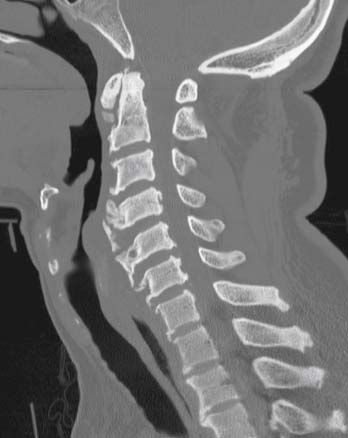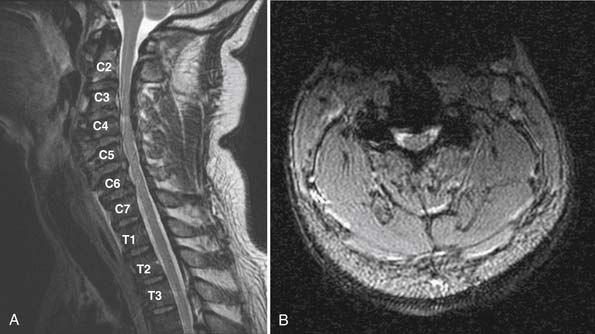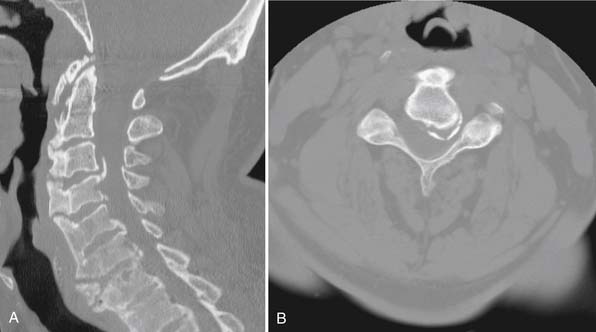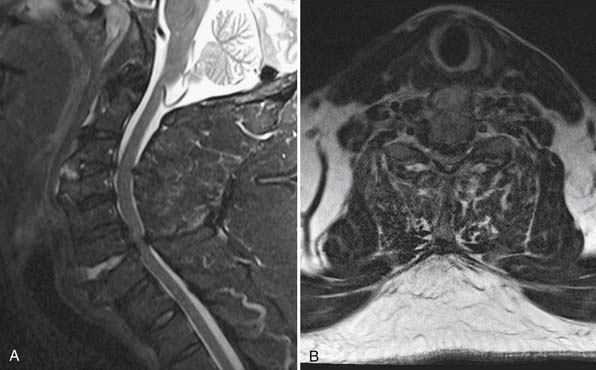29 Subaxial Cervical and Upper Thoracic Spine Fractures in the Elderly
KEY POINTS
Introduction
Although atlantoaxial fractures are more common than subaxial fractures in the elderly, there is considerable morbidity associated with subaxial cervical and upper thoracic spine fractures. These more caudal spine injuries are more likely to be associated with neurological deficits, in comparison to atlantoaxial injuries, and more likely to be associated with higher-energy mechanisms.1
Apart from the nearly ubiquitous osteoarthritic spondylosis seen in geriatric patients, other etiologies of severe cervical and thoracic spine ankylosis can alter the biomechanics of the cervical spine, causing increased susceptibility to fracture from minor traumatic events. These include ankylosing spondylitis (AS) and diffuse idiopathic skeletal hyperostosis (DISH). Both conditions result in a stiff and often osteoporotic spine. With injury, both the anterior and posterior columns may be completely disrupted, causing frank instability. Fractures of the ankylosed spine are associated with 50% morbidity and 30% mortality.2 For this reason, a high level of suspicion is required not to overlook potentially unstable fracture patterns.
The treatment of subaxial cervical and upper thoracic spine fractures continues to be evaluated. The subaxial cervical spine injury classification system (SLIC) has been established to provide clinicians with standardization for making nonoperative versus operative decisions and, ultimately, how to surgically approach the injuries.3 The traditional thinking regarding the most optimal timing of surgical treatment of injuries is also changing. Specifically, there is now good evidence that early surgical treatment of central cord injuries is superior to late treatment for certain categories of patients. Geriatric surgical techniques are also evolving; the complex and overlapping pathologies of osteoporosis and ankylosis present challenges for which meticulous preoperative planning may prevent certain postoperative complications.
Basic Science
The radiographic and clinical evaluation of the cervical spine in the patient following trauma continues to be evaluated. There are ongoing modifications of recommendations regarding the role of radiographs, multiplanar CT, and MRI to rule out cervical spine injuries in the trauma patient. Multiplanar CT and MRI have been shown to have very high sensitivity for detecting cervical spine injury. Despite a high sensitivity, there are reports of cervical spine injury in obtunded patients with an unremarkable multiplanar CT.4 Brandenstein and colleagues recently reported on four patients with negative cervical CT scans and MRIs who later had evidence of cervical instability.5 They estimated that 0.2% to 0.4% of their patients would have cervical spine instability despite normal CT and MRI findings. Not surprisingly, three of the four patients with instability were geriatric. It is prudent to have a high degree of suspicion for cervical spine injuries in the geriatric patient despite seemingly normal imaging.
Ankylosing Spondylitis
Ankylosing spondylitis (AS) is a seronegative (RF-negative) spondyloarthropathy that predominantly affects the sacroiliac joints and spine. It typically, but not exclusively, affects HLA-B27–seropositive patients. The prevalence ranges from 0.1% in African and Eskimo populations to as high as 6% in Haida Native Americans in northern Canada. The white populations of the USA and UK have a prevalence of 0.5% to 1.0%. AS typically has its onset in the third decade of life, with a mean age of onset of 26. It rarely begins after the age of 40, although the diagnosis may be made at a later age because earlier symptoms are ignored or benign. A juvenile form of AS is described, but it does not affect the spine.
Clinical Case Examples
CASE 1
Imaging evaluation revealed extensive degenerative changes. Posterior osteophytes from C3 to C7 and calcification of the posterior longitudinal ligament were demonstrated on CT scanning. There was no fracture, malalignment, or prevertebral edema appreciated (Figure 29-1). An MRI revealed C3-4 disc osteophyte complex associated with spinal cord compression and T2 hyperintensity of the cord. Additional disc protrusions were seen at more caudal cervical levels (Figure 29-2).

FIGURE 29-1 Case 1: Midsagittal CT of cervical spine shows multilevel degenerative changes without evidence of fracture.
He was initially treated with cervical collar immobilization. His neurological examination was monitored. The patient showed no improvement in his neurological examination. The recommendation to decompress and stabilize the cervical spine was accepted by the patient. A posterior direct decompression with instrumented fusion was performed from C3 to T1 (Figure 29-3).
Case 2
Imaging evaluation demonstrated several disc osteophyte complexes. The largest was observed at C3/C4, where there was 50% narrowing of the central canal. Extensive flowing nonmarginal osteophytes were also well characterized by CT scan (Figure 29-4). While no obvious unstable injuries were appreciated on CT, a subsequent MRI revealed extension distraction fractures with three column disruption at both C3-4 and C6-7. Each level of injury was associated with dissociation of the anterior longitudinal ligament and osteophytes (Figure 29-5). The spinal cord was compressed at C3-4 and C6-7.
A C3 to C7 laminectomy and C3 to T1 instrumented fusion were performed. He tolerated the procedure well and was extubated in the operating room (Figure 29-6). Since the patient’s body habitus limited the adequacy of intraoperative radiographs, a CT scan was performed immediately postoperatively to evaluate the spinal alignment and instrumentation (Figure 29-7).

FIGURE 29-6 Case 2: Postoperative AP and lateral cervical spine x-rays with good sagittal and coronal alignment. Hardware in appropriate position without evidence of complications.












